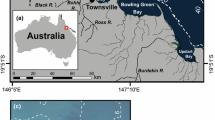Abstract
Kikai-jima in the central Ryukyu Islands of Japan is fringed by exposed terraces of Holocene reefs, which formed as a result of periodic local tectonic uplift associated with subduction/collision. The terraces form four topographically distinct features (TI-IV) around the island and represent reefs that grew to sea level at 9000–6065 y BP, 6065–3390 y BP, 3790–2630 y BP, and 2870 to 1550 y BP. The modern reef terrace has been growing since approximately 1550 y BP. The reef terraces were uplifted sequentially around 6050 y BP (4 m), 3390–3790 y BP (2.5 m), 2630–2870 y BP (1 m) and 1550 y BP (2.5 m). Five sites were studied to define reef development in response to periodic relative sea level fall and different stillstand recovery periods. Thirty coral genera and 70 species were recorded from four distinct shallow reef flat to upper reef slope and one deeper reef slope coral assemblage. Significant lateral variations in total coral abundance, genera number, diversity, and the coverage density of Acropora spp. and Faviids occur both within and between the terraces. Stratigraphically, drill core and outcrop data recorded shallowing upward sequences characterised by tabulate Acropora spp. overlying massive Porites sp. and Faviids. The biological variations may represent growth strategies responding to initial colonisation, episodic perturbation (relative sea level fall) and differing recovery times during stillstands, and indicate a reef ecosystem stable and strong enough to recover after substantial perturbations. However, this study suggests that relatively small geological changes have had substantial biological effects, and modelling indicates that such changes would have been more profound had a third factor, such as substrate angle, varied more dramatically. In such a case, the drowning growth strategy exhibited in the drill core transect may have been more prevalent, and reefs would be struggling to grow around Kikai-jima today.
Similar content being viewed by others
Author information
Authors and Affiliations
Additional information
Accepted: 27 May 1998
Rights and permissions
About this article
Cite this article
Webster, J., Davies, P. & Konishi, K. Model of fringing reef development in response to progressive sea level fall over the last 7000 years – (Kikai-jima, Ryukyu Islands, Japan). Coral Reefs 17, 289–308 (1998). https://doi.org/10.1007/s003380050131
Issue Date:
DOI: https://doi.org/10.1007/s003380050131




